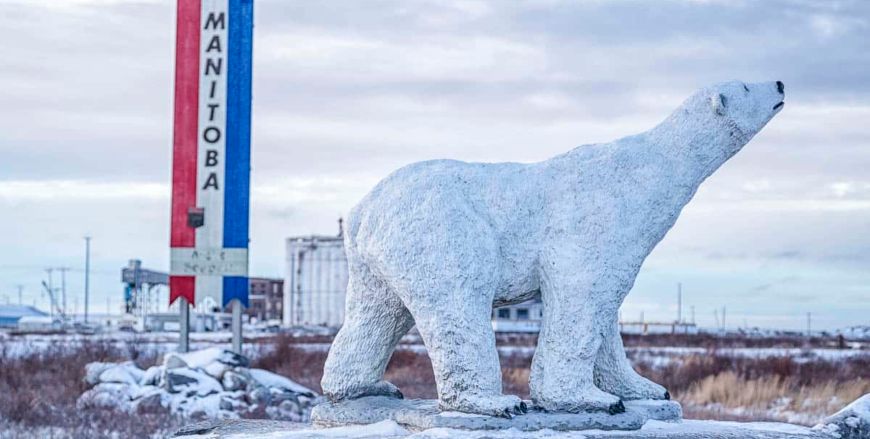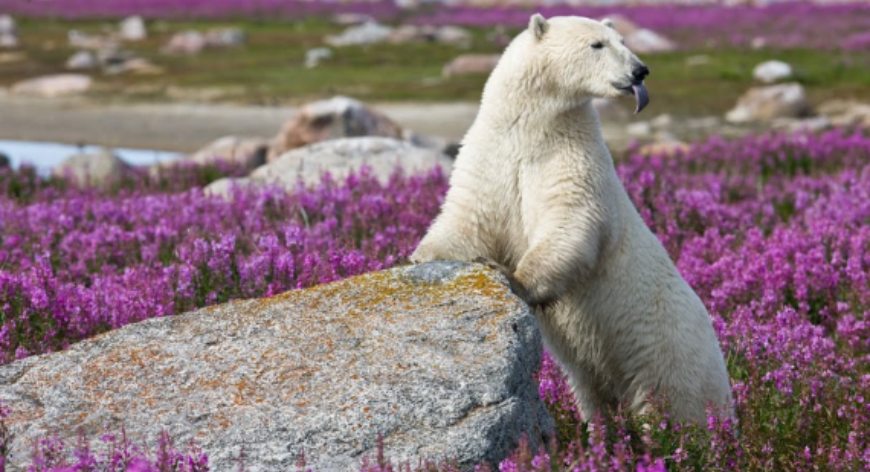Want to see polar bears in the wild? Canada is the perfect place. With over 16,000 polar bears roaming across its different regions, you can get closer to these amazing animals than anywhere else. In Churchill alone, visitors see an average of 300 different bears each season through October and November. Take a ride in special trucks called tundra buggies, where bears walk right past your window, or visit quiet spots where you can watch mother bears care for their tiny cubs. We’ll show you all the best places to watch polar bears safely and learn about their amazing lives.
Promoting Polar Bear Tourism Through Online Casinos
Canada’s polar bear tourism is a big part of its Arctic heritage, drawing visitors from all over the world to see these amazing animals. Surprisingly, industries like online gaming have found unique ways to support this cause. Casinos featuring Arctic-themed games inspired by polar bears and other wildlife are gaining popularity. A great example of this is the growing interest in locally trusted entertainment sites, which provide Manitoba online casino players with expert reviews, detailed comparisons of the best gambling sites, and practical tips for responsible play.
These platforms make it easier for players to find trusted Manitoba online casinos, ensuring a safe and enjoyable experience. Additionally, they often highlight exclusive offers, like bonuses and rewards, while guiding users to sites that align with industry standards and player preferences. By blending entertainment with expert insights, these platforms connect players with the best options while contributing to Manitoba’s vibrant gaming scene.
One of the most extraordinary destinations to experience these magnificent creatures is Churchill.

Churchill: Polar Bear Capital of the World
The town of Churchill, Manitoba, sits at a unique spot where polar bears gather during their annual migration along Hudson Bay. The town’s strategic location at 58°N latitude puts it directly on the bears’ natural path between summer grounds and winter hunting areas. With around 1,000 residents, Churchill has mastered the delicate balance of tourism and safety, allowing visitors to observe these magnificent predators up close while protecting both humans and bears.
The Western Hudson Bay bear population uses this region as a crucial gathering point each year. Male polar bears in Churchill can weigh up to 600kg, making safety protocols essential. Through decades of experience, the town has developed sophisticated ways to manage human-bear interactions through collaboration between Manitoba Conservation, Parks Canada, and local experts.

Best Time to Visit Churchill
- October-November: Peak season with lots of bears
- February-March: See mothers with cubs
- Summer: Watch bears swim and lounge on the coast
- July-August: Bonus chance to see belugas too
How to Watch Bears Here
- Tundra Buggies
These custom-built vehicles stand about 3.5 meters high on massive tires, keeping visitors safely above bear height. Each buggy features heated indoor viewing areas and outdoor observation decks, complete with professional guides who explain bear behaviour. Tours typically last all day, giving guests plenty of time to observe and photograph these incredible animals.
- Helicopter Tours
Hour-long flights take small groups over bear territory, offering unique aerial perspectives. Experienced Arctic pilots know exactly where to find bears, making these tours perfect for photographers who want both close-ups and landscape shots. The flights also help spot mothers with cubs in areas not accessible by ground vehicles.
- Walking Tours
Guided walking tours offer the most intimate bear-watching experience. Small groups venture out with armed experts who know bear behaviour inside and out. While exciting, these tours require strict adherence to safety protocols and depend heavily on weather conditions.
Staying Safe
Churchill takes bear safety very seriously. Over many years, the town has created a smart system to keep both people and bears safe. Everyone works together – locals, tour guides, and visitors all do their part. It’s like having a whole town on bear patrol!
Here’s how Churchill keeps everyone safe:
- Special bear hotline that works 24/7 (just call 204-675-BEAR)
- A “bear jail” for bears that come too close to town
- Officers who watch for bears day and night
- Special garbage bins bears can’t break into
- Warning systems to tell people when bears are nearby
- Safe buildings where people can go if they spot a bear
- Teachers who show people how to stay safe
- Rules about not walking alone at night
- Must have guides when going outside town
- Cars stay unlocked (in case someone needs to jump in quickly)
- Helicopters to move problem bears away
- Daily updates about where bears have been seen
Arviat: An Arctic Cultural Experience
Up in Nunavut, this Inuit community of 2,800 people offers something truly special. Located 100km south of the bear migration route, Arviat blends wildlife watching with authentic cultural experiences. Local guides share traditional knowledge passed down through generations while ensuring safe polar bear viewing. The community’s strong artistic traditions, including distinctive stone carvings and traditional music, add depth to wildlife tours.
What Makes Arviat Special
- Local Inuit guides share traditional knowledge
- Smaller groups than Churchill
- Cultural demonstrations included
- October-November best for bears
- Great for seeing other Arctic animals
- Traditional art and carvings
Wapusk National Park: Where Cubs Take First Steps
Established in 1996, this vast park (11,475 square kilometres) protects one of the world’s largest polar bear denning areas. Its name comes from the Cree word for “white bear,” reflecting the region’s rich indigenous heritage. The park’s unique location, where boreal forest meets Arctic tundra, provides perfect conditions for mother bears to dig their winter dens in deep snowdrifts. Access is strictly controlled through licensed operators, making it an exclusive but remarkable destination for wildlife enthusiasts.
The Wapusk Experience
- See mother bears and cubs emerge from dens
- February-March best time
- Fly-in access only
- Very few visitors allowed
- Professional photography guides
- Pristine wilderness setting
Comparing the Best Polar Bear Watching Spots in Canada
Feature | Churchill | Arviat | Wapusk |
|---|---|---|---|
Access | Train/plane | Fly only | Fly-in tours only |
Best Season | Oct-Nov | Oct-Nov | Feb-Mar |
Accommodation | Many hotels | Limited | Very limited |
Tour Options | Many | Few | Very few |
Cultural Experience | Some | Strong | Limited |
Cost | Moderate-High | High | Very High |
Visitor Numbers | High | Low | Very Low |
Family Friendly | Yes | Moderate | No |
Photography | Good | Good | Excellent |
Other Wildlife | Yes | Yes | Yes |
Polar Bear Conservation in Canada
Are there polar bears in Canada? Absolutely, as approximately 65% of all polar bears on Earth live here. It is home to most of the world’s polar bears, with about 16,000 of them roaming across the Arctic. That’s about 65% of all polar bears on Earth. Recent studies by Environment Canada show these bears face big challenges. The ice they need for hunting is forming about 3-4 weeks later than it did 30 years ago, giving bears less time to build up fat reserves by hunting seals. In Hudson Bay, where Churchill’s bears live, this change is very clear – bears now spend almost a month longer on land than they did in the 1980s.
The Canadian government works with local communities, scientists, and international partners to protect these bears. Here’s what they’re doing:
Current Status:
- 16,000 polar bears in Canada out of 25,000 worldwide
- Scientists watch 13 different bear groups closely
- Ice forms about 3-4 weeks later each fall
- Bears stay on land longer than ever before
- Some bears are getting thinner and having fewer cubs
Protection Programs:
- Churchill’s special bear patrol and alert system
- Big protected areas like Wapusk National Park
- Working with other Arctic countries to help bears
- Scientists studying bears year-round
- Local communities helping watch and protect bears
- Special rules about hunting and tourism
- Teaching people about bear safety and conservation
10 Ways to Help Save Polar Bears
- Support polar bear research programs through donations.
- Reduce your carbon footprint at home.
- Support Arctic habitat protection laws.
- Choose eco-friendly tour operators.
- Follow all wildlife viewing guidelines.
- Share accurate information about polar bears.
- Join citizen science projects.
- Cut down on plastic use.
- Support clean energy projects.
- Learn about Arctic conservation issues.
Planning for Your Polar Bear Tour in Canada
What to Pack
- Really warm boots (rated for -40°C)
- Lots of layers (base, middle, outer)
- Wind-proof jacket
- Hand and toe warmers
- Camera with zoom lens
- Extra batteries (cold drains them fast)
- Good binoculars
Tips for Success
- Book early (especially for October-November)
- Get travel insurance (weather can change plans)
- Listen to your guides
- Be patient (wildlife viewing takes time)
- Respect local communities
- Follow all safety rules
Whether you pick Churchill’s easy access, Arviat’s cultural experience, or Wapusk’s exclusive wildlife viewing, seeing polar bear trips in Canada is truly unforgettable. These trips often include the chance to stay in unique accommodations like the polar bear ice hut, enhancing the adventure. Just remember: these aren’t just tourist attractions – they’re wild animals facing real challenges. By visiting responsibly, you help protect them for future generations.
When planning, consider what animals are only found in Canada. For example, Canada is home to unique creatures like the muskox and the muse animal, both iconic symbols of Arctic wildlife. Additionally, animals only found in Canada, such as the Vancouver Island marmot, make this region distinct. So, can you see polar bears in Canada? Yes, and it’s a chance to witness these majestic creatures in their natural habitat while supporting important conservation efforts.
